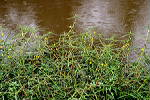

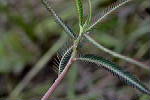
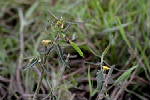
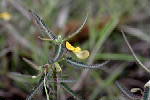

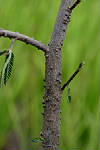
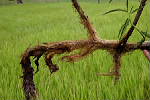
Botany Biology Phenology Ecology Distribution Agricultural importance Cultural control Biological control
| Description : | Terrestrial or aquatic, perennial, erect subshrub up to 200 cm tall, partially submerged. Taproot or fibrous roots white or brown, rooting in the substrate under water. Stems rounded, solid, warty, glabrous or hairy, often with white, spongy parenchyma at base (under water). Stipules present, triangular, glabrous. Leaves compound, paripinnate, alternate spiral, stalked, leaflets glabrous on both sides, glaucous below, margin entire, apex obtuse, base obtuse or rounded, pinnately veined. Flowers bisexual, grouped together in an axillary, 1 to few- flowered raceme, stalked, petals 5, yellow. Fruit an articulated pod. |
| Seeds : | Brown to black, glossy, oblong-kidney-shapped, 2-2.5 x 3-3.5 mm, with thin endosperm. |